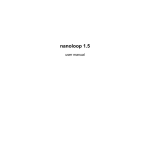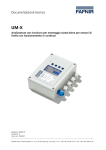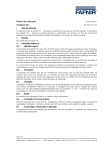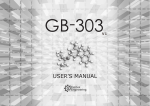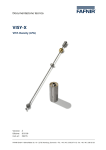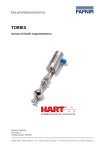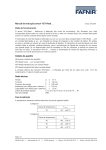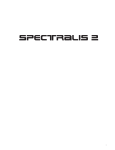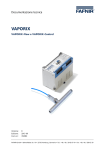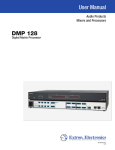Download nanoloop 2.3
Transcript
nanoloop 2.3 user manual Introduction Nanoloop is a Stepsequencer which means that a pattern of 16 1/16 notes is played repeatedly while these notes can be edited in various respects like volume, pitch etc. There are four channels, playing simultaneously. Each channel's patterns can be saved to file slots in flash memory and are then available for new combinations. Finally, saved patterns can be arranged in a song structure. Startup Start nanoloop with START or SELECT to run it in color or b/w mode. Do not try other buttons, some 3-key combinations are reserved for special functions such as memory reformat. 2 The Sequencer The 16-step pattern is shown as a matrix of 4 x 4 squares with the currently playing step marked in slightly darker color . The current channel is displayed in the upper left corner, the current edit parameter in the upper right corner. Within this matrix, the cursor can be moved around with the d-pad. Use the keys to set notes: B A Set note Remove note / paste removed note if step is empty 3 To edit a note, keep B pressed and press the d-pad up / down (▲/▼) or left / right (◄/►). This changes the value of the current edit parameter, indicated by little dots and squares changing their position. On startup, the edit parameter is pitch and B + ▲/▼ changes pitch semitone-wise while B + ◄/► changes the octave. To select a different channel or parameter, call menu 1 with SELECT Menu 1 In menu 1 you can select channel and edit parameter. Furthermore, all notes in the sequencer can be edited simultaneously. ◄/► ▲/▼ B select parameter select channel return to sequencer A + ◄/►/▲/▼ R + ►/▲ edit all notes at once randomize current parameter SELECT switch to menu 2 (see page 8) 4 Channels There are three tonal channels and one for noise. The tonal channels have two synthesis modes: filtered rectangular waves with variable pulse width and FM synthesis with variable modulator frequency. The noise channel has a pseudorandom and a filter mode. Only one channel is visible at a time. R L S N monophonic synthesizer monophonic synthesizer polyphonic synthesizer noise Edit Parameters The following parameters are available for editing in the sequencer: 5 Volume / Envelope B + ▲/▼ B + ◄/► START L+B volume length set A-, A/D-mode set length to infinite Pitch B + ▲/▼ START semitone set chord-mode in normal mode: B + ◄/► octave in chord mode B + ◄/► B + R + ◄/► B+L select note octave R,L: set retriggering of envelope S: set detune mode On channel R and L, chords are played as arpeggio. Chord notes in the highest position are muted. S is polyphonic and plays actual chords. 6 pitch- / filter - envelope / -lfo B + ▲/▼ B + ◄/► START amplitude length / frequency envelope- / lfo-mode On channel R and L, this acts as pitch envelope / lfo, on channel S and N it affects the filter cutoff (rect wave, noise) / modulation depth (fm). synthesis B + ▲/▼ B + ◄/► START B+L filter cutoff / modulation depth pulse width / modulator frequency set low- / bandpass filter set filtered wave / FM synthesis N: set pseudorandom / filtered noise pan / delay B + ▲/▼ B + ◄/► START delay pan position play original note plus delay or only delay 7 Menu 2 Menu 2 provides links to sub-menus and some functions that affect the entire channel. SELECT returns to Menu 1. B call file menu B call song editor B+◄ START B+► ping-pong playback mode random playback mode normal playback mode B + ◄/► A + ◄/► B + ▲/▼ START A+B shift pattern backwards / forwards shift pattern backwards / forwards, preserving delay pattern length copy pattern paste pattern B + ◄/► B + ▲/▼ A+B START global tempo in BPM set channel tempo to fraction of global tempo external sync internal sync 8 File Menu In the file menu, patterns can be saved to file slots in flash memory for persistent storage in 128 banks. In each bank there is a row of 15 slots for each channel (slot 0 is not writeable). SELECT returns to menu 1. File Operation ◄/► ▲/▼ select file slot select channel for current channel: B+▼ B+▲ save current pattern to selected slot load pattern from selected slot for all channels at once: A+▼ A+▲ save current patterns to selected slots load patterns from selected slots 9 A+B+▼ A+B+▲ delete file in selected slot load empty file to current channel A+B+► A+B+◄ solo / umute current channel mute current channel START switch to upper menu File slots have a darker background color when filled with data. Tempo The current bpm value is saved with each pattern and shown in the lower right corner. It is not loaded with B + ▲ though to avoid unwanted sudden tempo changes. Instead, tempo is only loaded with B + R +▲ (load pattern with tempo) and R+▲(load tempo only). 10 Upper Menu bank selection, copy & paste B + ◄/► B + ▲/▼ increase/decrease bank no. by 16 increase/decrease bank no. by 1 A+B+▲ A+B+▼ copy current bank to buffer overwrite current bank with buffer It is possible to write the copied bank in the buffer to an other nanoloop 2.3 cart. Simply remove the cart (sounds will change), insert the other one, select a bank and press A + B + ▼. bank name (blank by default) Next to the bank number, there is an 8-digit bank name ◄/► B + ▲/▼ select digit set letter The name is saved when changing bank or leaving the menu. 11 data communication A+B+▼ SELECT receive bank to buffer cancel After data were received successfully, they are in the copy buffer and can be saved to the current bank with A+B. A+B+▲ SELECT encode bank as audio pulses cancel After the bank was encoded, audio playback can be started with B. START interrupts playback, it can be re-started from the beginning with B again. A+B+◄ receive software update CAUTION: The encoded audio is not music but very loud pulse noise. It is not meant for listening but for (mis-) using audio media for data storage. Please make sure the audio output is not connected to an amplifier / speakers before playing the encoded data. Please read the detailed instructions available on www.nanoloop.com before using these functions. 12 Song Editor The current bank's saved patterns can be arranged to a song. The song structure is organized in 15 pages, if you move the cursor to the far right or left, the next / last page is displayed. B + ▲/▼ B + ◄/► A+▲ R START select pattern copy current value to next/previous step load patterns on cursor position select current channel for tempo start / stop song playback SELECT return to menu 2 When leaving the song editor, playback is stopped and the song is saved. (the song is not saved when the device is turned off without leaving the song editor) 13 Additional Notes Note Value Display Notes can appear as bars and dots (default) or as letters. Press START on the note icon in menu 1 to set pitch display to letter form. Arpeggio for Melodies The arpeggio plays exactly four notes per step, but if the channel tempo is set to 1/4 speed, it will be one note per step. So arpeggio can be used to play longer melodies (4 bars) within one pattern. If enveloperetrigger is activated, the four notes are only played once instead of being looped (default) which may be helpful when using arpeggio for melodies. Hex Numbers Except for BPM, numbers are shown in hexadecimal format which means that each digit has 16 values instead of 10. For values 10-15, the letters A-F are used. 14 Flash Memory Writing to flash memory requires to erase data first in a separate step which cannot be performed during audio playback. Nanoloop therefore compresses data and reformats memory on each startup (during this process, a triangle is displayed on the intro screen). When a loop or song is saved in the file menu, the old file is not overwritten but the new version is appended. During reformatting, memory is cleared and only the newest version of each file is kept. Thus only a limited number of file accesses may be performed until nanoloop needs to restart and reformat memory. However, this number is very large, it is possible to save a few thousand loops or to copy about 100 banks before the limit is reached. If memory is almost full, the number of remaining possible file accesses is displayed and when these are used up, saving is disabled until nanoloop is restarted. After restart, the limit is set back to about 10,000. So under normal circumstances one would hardly reach that limit. If you actually save more than 10,000 loops in one day it may be time to take a break anyway.. The more banks are filled, the longer reformatting on startup will take. With all slots in all banks used it takes about 20 seconds. Data are always in a defined state, it is save to turn off the device during reformatting, no data will be lost. 15 Further information and a discussion forum can be found at the nanoloop website: www.nanoloop.com For questions and comments please send an email to [email protected] Postal: ume software Bahrenfelder Str. 53 22765 Hamburg Germany (c) 1998-2008 Oliver Wittchow Nintendo has not recommended, authorized, endorsed, approved of or licensed Nanoloop. 16

















